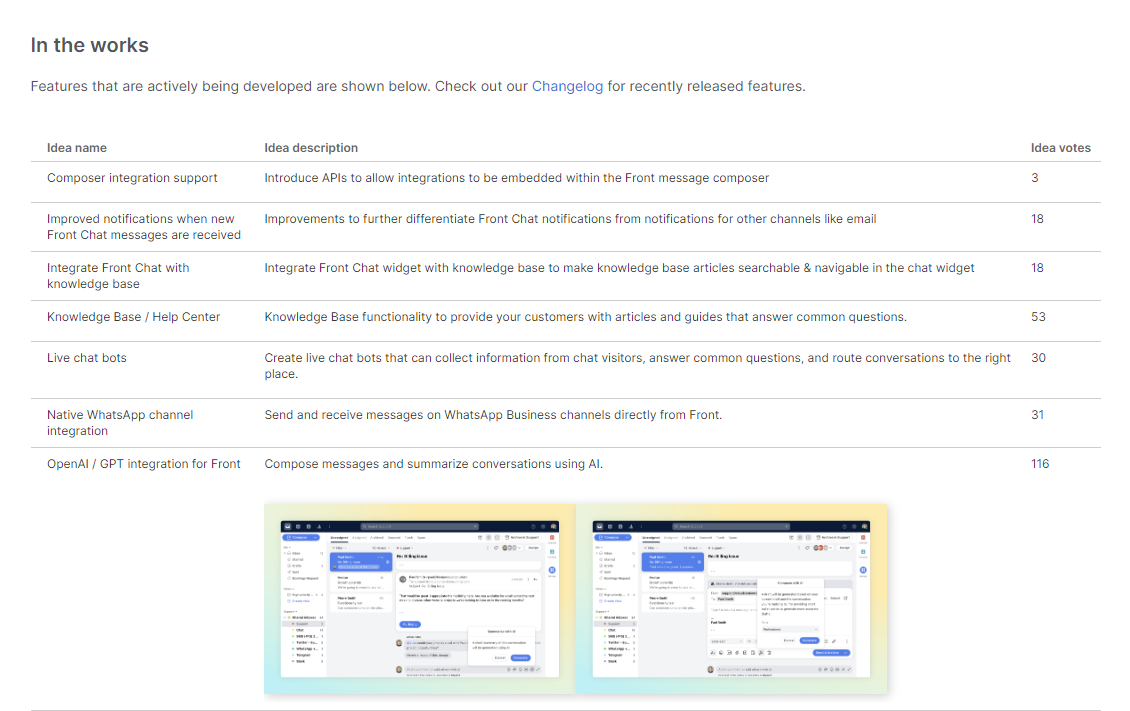Back in the early days of starting Front, we launched a public roadmap on Trello. This post details how we did that on Trello and why we did it. Today, we still have a public roadmap because we continue to value transparency and accountability, and you can find it here.
What’s a public product roadmap?
Our public roadmap is a freely accessible page where our users can find what we’ve shipped recently, what we are currently working on, and some ideas of what we should be doing next. More importantly, users can voice their opinion and vote for the features they most urgently want to see implemented.
When we feel like a feature is important enough to be prioritized, we move it into our product pipeline, where users can follow its progress, from design to development to shipping.
It was a big decision to make and we put a lot of thought into it (see below for the details), but once we opted for it, it literally took us 2 minutes to launch it.
The 2-minute guide to a public roadmap
We wanted to keep it clean and simple, so we used Trello’s board organization before switching to Aha. It takes no more than 3 steps:
Create a new board
Make it public (Private > Change Visibility > Public)
Enable public vote (Menu > Power-ups > Voting)
Optional: Enable public comments (tread carefully — we decided not to).
The reaction of our users exceeded our expectations. Cheer from our users is great, but it’s even better when we can use it to improve our product. The public roadmap has already helped us collect valuable feedback e.g. the native iPhone app was far more urgent than we anticipated, and 4 times more requested than the Android app: we instantly added it to our next product cycle.
The benefits of a public roadmap
We expect this public roadmap to be the cornerstone of our (non-support related) user feedback. Why am I so enthusiastic about it? For three reasons:
1. Users like it
We expected this one. Front is all about disseminating information to all those who can benefit from it, thus increasing transparency within companies.
We value transparency because it makes people happy. When you let people in on a secret, they feel so involved that they want it to succeed beyond their personal interest. That is what is so powerful about transparency. And this brings tangible results: people who’ve worked on problems similar to those described in our roadmap have proactively offered their help!
2. The product gets better, faster
This one was a bit of a gamble. From Fords quote about his customers asking for faster horses instead of cars, to Steve Jobs’s total disregard for focus groups and market research, a common trope in product development suggests that you should not ask your users what to build next. Your duty is to do the hard work of anticipating the needs, building the best corresponding product, and delivering it as early as possible.
In a way, we still believe in that. Of course, we have a vision for Front. Of course, we know what we have to build. But the opportunity to lay out this vision in front of our users eyes, and ask them to show us the easiest path the get there, is invaluable. We suggest the ideas that we feel most strongly about and let our users tell us what really clicks with them. Win-win.
3. The team is accountable in the most direct manner
This one caught us off guard. By adding a lot of transparency to our workflow, we introduced something new and very powerful: accountability. When our users clearly state what they want from us, we really have no excuse for not delivering it. If we disregard the public vote and not move a feature to the pipeline, people will know it; if something is stuck at the design stage forever, people will call us on it; etc.
But it’s a good thing: now the team can rest assured that the features we’re building were not pulled out of thin air and that many users will genuinely be happy to get them. It gives a supplemental feedback loop to the product development process, and the net effect has been very positive on the team.
As you can see, so far we only have good news to share about this roadmap. A possible drawback is that everything is out there for our competitors to see, but we don’t really see it as a problem certainly not a big enough problem to offset the positive aspects. What sets us apart is not the number of good ideas we can keep to ourselves, but rather what we can make out of a good idea.
The team at ClickUp also rounded up some quality product management templates for building roadmaps, which you might find handy when you’re getting started.
Learn about our product development team uses Front to build a customer-centric product.
Written by Mathilde Collin
Originally Published: 31 May 2022











